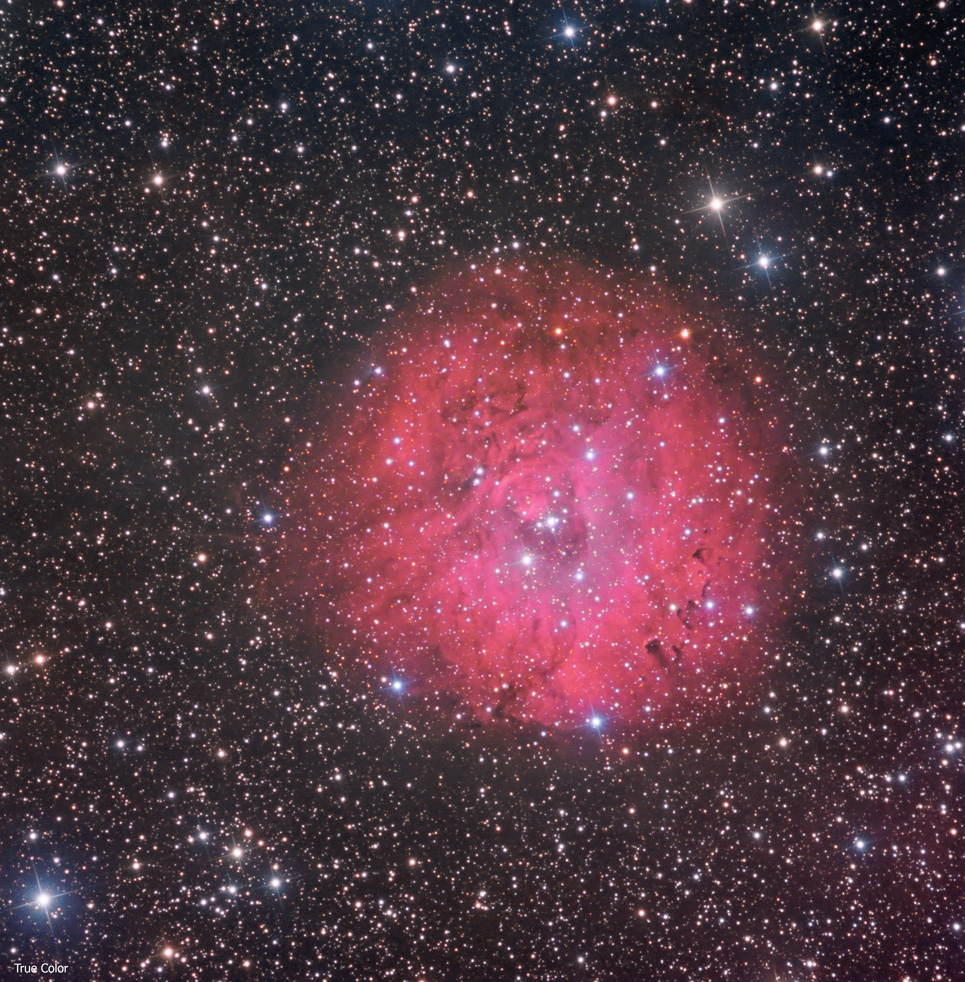HOME
Sh2-170
Sh2-170
(Sharpless 170)
Emission Nebula (with open star cluster) in Cassiopeia
Click here for higher-resolution versions: 40% (1544x1572) 65%
(2510x2556) 100% (3861x3961)
 Click on image to cycle through the three versions of the image (leveled on the lower left of each image, and described below)
Click on image to cycle through the three versions of the image (leveled on the lower left of each image, and described below)
Sharpless 170 is a very faint emission nebula, with an associated open star cluster. As is the case with most emission nebulae, Sharpless 170 is a star-forming region.
The emission nebula is very predominantly red, because (i) ionized hydrogen emits in the red part of the spectrum; (ii) the vast majority of the light matter in the universe is hydrogen, and
(iii) the hydrogen is being ionized (stripped of its electron) by a highly-energetic young star in the center of the nebula.
Because of its resemblance to the
Rosette Nebula, this object sometimes is called "The Small Rosette Nebula," although Sharpless 170 is much smaller and dimmer than the Rosette Nebula.
Sharpless 170 is about 7,500 light years away from Earth, and has an apparent diameter of about 2/3 of the diameter of the full moon, giving it an actual diameter of about 45 light years.
It has recently been been discovered that the star cluster associated with Sharpless 170 contains many
variable stars.
I have presented this object in three different formats (each image is labeled in the lower left corner); each is interesting in its own way. This is the order in which they appear as you cycle
through (by repeatedly clicking on the photo, waiting for each to download):
(i) A true-color version (the top photo in the stack), with the color created by imaging through red, green and blue filters (with a significant amount of Ha and OIII
data blended into various channels, in varying percentages; Ha emissions are in the red spectrum, and OIII emissions are blue-green, so I have blended Ha into the luminance layer and the red channel,
and OIII into the green and blue channels);
(ii) A version in the Hubble palette (a lot of the Hubble photos, including and especially the famous "Pillars of Creation," are made with this set of filters, since
it's a useful set for scientists to see what's actually happening), which shows SII emissions as red, Ha emissions as green, and OIII emissions as blue (with the Ha emissions de-emphasized in this
rendition because they would be so dominant otherwise--but I still keep a lot of green in the nebula). I like the clear blue when a nebula has significant oxygen emissions. Because Ha is so dominant
in this nebula, and I'm not all that fond of a strong green in a photo, I have partially-neutralized the green, to become kind of brown);
(iii) A pure Ha version (grayscale, showing only light in the very narrow Ha band); this is fun for me to gaze at in full resolution, to see all the detail.
These are the three most frequent ways images of emission nebulae are likely to be presented, so I thought it would be fun to include all of them, to be able to compare and contrast the different presentations.
The "true color" version (which includes narrow-band data) is, to me, the most beautiful of the lot, so I put it at the top; the narrow-band data adds contrast and detail to the image, and makes
the stars smaller, which is pleasing to me, while maintaining the "true color" nature of the data. The Hubble palette version is also very pretty, and it's nice to include the (relatively sparse)
sulfur emissions that I spent a bunch of hours gathering.
The grayscale Ha image is, to me, striking in its smoothness (and the gray, of course, is the color you see when you look at this through a telescope). The bicolor is there for comparison purposes,
since a lot of people use only those two filters when creating color images of diffuse nebulae.
.
Technical Information:
Ha:OIII:SII:R:G:B: 390:510:390:195:180:240 (a total of over 31 hours of light-frame exposure time); red and green exposures were all 15-minute exposures;
blue all 20-minute exposures; Ha, SII and OIII were all 30-minute exposures.
Equipment: RC Optical Systems 14.5 inch Ritchey-Chretien carbon fiber truss telescope, with ion-milled optics and RCOS field flattener, at about f/9, and an SBIG STX-16803 camera with
internal filter wheel (SBIG filter set), guided by an SBIG AO-X, all riding on a Bisque Paramount ME German Equatorial Mount.
Image Acquisition/Camera Control: Maxim DL, controlled with ACP Expert/Scheduler, working in concert with TheSky X.
Processing: All images calibrated (darks, bias and sky flats), aligned, combined and cropped in Pixinsight. Color combine in Pixinsight. Some finish work (background neutralization,
color calibration, deconvolution and noise reduction) done in Pixinsight; since I did not get any luminance-filtered data, I created an artificial luminance layer by integrating the R, G and B channels,
in Pixinsight; some cleanup finish work was done in Photoshop CC.
Location: Data acquired remotely from Deep Sky West Remote Observatory, Rowe, New Mexico, USA.
Date: Images taken on many nights in November and December of 2019. Image posted February 23, 2020.
Date: Image scale of full-resolution image: 0.56 arcseconds per pixel.
Seeing: Generally quite poor
CCD Chip temperature: -25C
Copyright 2019, 2020 Mark de Regt
